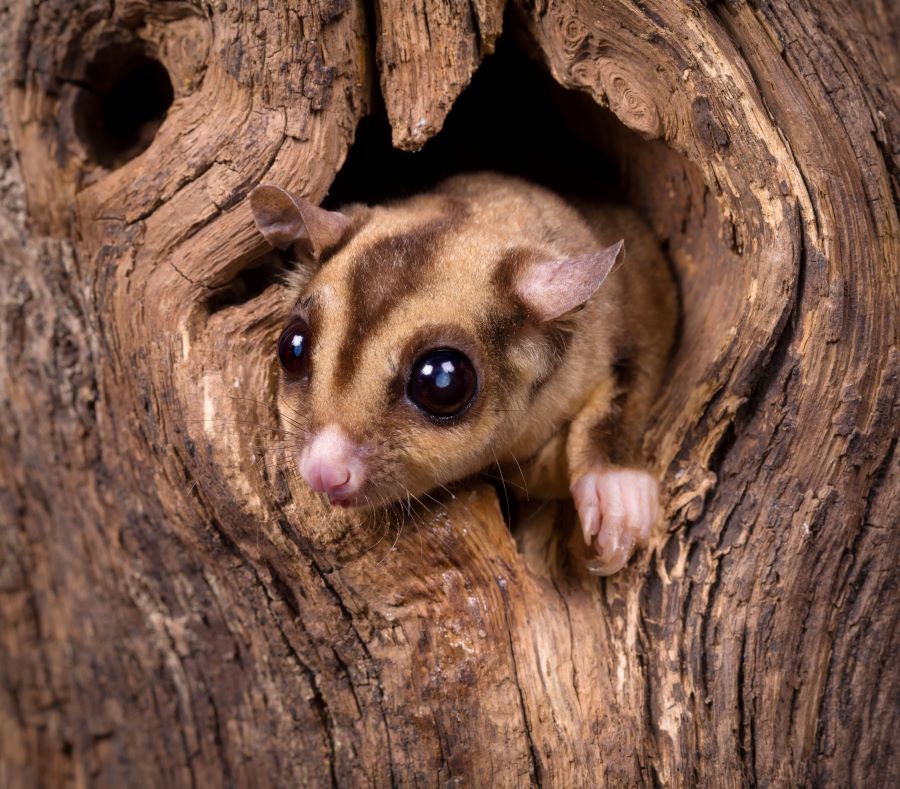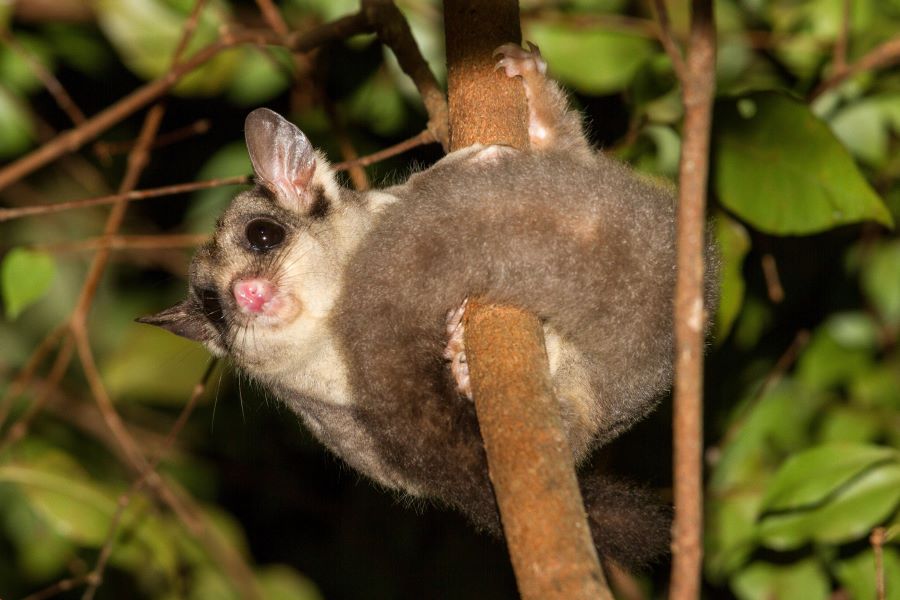Some of the posts on Mercury Pets contain affiliate links to products. That means if you click on that link and then make a purchase, we receive a percentage of the sale. We only recommend products we’ve used and support, and there’s no additional cost to you — the money goes right back into making this site the best it can be! Thanks for reading.

Sugar gliders are absolutely adorable animals that make unique pets to humans who care about providing them with the right food and living conditions.
If you’ve found this article, there’s a chance you are either planning to or already own a sugar glider and want to find out more about their hibernation habits.
Sugar gliders do not hibernate. Instead, when cold or rainy weather appears, they go into a state of reduced activity called torpor. Torpor involves a decrease in metabolic and physiological activity to help preserve energy and keep sugar gliders alive.
This article aims to explain exactly what torpor is, why sugar gliders use it instead of hibernation to survive, and how exactly torpor keeps them alive during the cold, wintry months.
What is Torpor?
Sugar gliders are native to South Eastern Australia, a region that’s not really well known for getting very cold.
As a result, sugar gliders can tolerate temperatures up to 40 degrees Celsius (or 104 Fahrenheit). They do this by finding creative ways to keep themselves cool, like licking their coats and staying hydrated.
However, if a sugar glider is exposed to cold weather, it will either seek a warm spot to huddle in or enter a state of torpor to preserve energy.
Before the onset of torpor, sugar gliders drastically reduce their activity and willingly lower their overall body temperature. Unlike hibernation, torpor only lasts for less than a day and allows the sugar glider to resume activity at any point regardless of the weather.
Once a sugar glider enters torpor, its body temperature can drop to anything in the range of 10-19 degrees Celsius (50-67 Fahrenheit).
This helps it save all the energy it would have needed to maintain its body temperature and use that energy for essential functions instead.
How Does Torpor Work?
When food is scarce, and cold temperatures threaten to increase the amount of energy required to keep a sugar glider’s body temperature raised, these resourceful creatures make an interesting trade-off.
They allow their body temperatures to drop drastically and go into a state of complete inactivity to preserve as much energy as possible.
Before doing this, though, sugar gliders must build up as much body fat as possible before the winter months arrive. This means sugar gliders will be at their plumpest during May in Australia before winter.
Many animals that hibernate also go through stages of torpor, during which their body temperatures drop, and their metabolic activity decreases significantly.
Scientists believed sugar gliders going into torpor just wholly switched off their ability to regulate their body temperature. This is untrue.
Sugar gliders in torpor still maintain some control over their core temperatures and can choose when to raise it if necessary.
Raising Body Temperature
Not much is known about how exactly sugar gliders raise their body temperature once they’re ready to come out of torpor. Many scientists believe fat cells play an essential role in the process, but there’s not enough research to support these claims.
However, there is no doubt about the effectiveness of torpor for helping sugar gliders survive. Small mammals that choose to maintain their body temperatures and activity levels during winter spend more than 100 times the energy sugar gliders do during the same amount of time in torpor.
Once a sugar glider feels the need to forage or wants to move, they raise their temperatures, increase their metabolic rate, and return to their pre-torpor state within minutes.
How Long do Sugar Gliders Stay in Torpor?
Although most sugar gliders can enter torpor whenever they choose, most of these adorable little animals will go into torpor during the day and forage between sunset and sunrise. However, if nights are especially cold or rainy, they may remain in torpor and only awaken once the bad weather ends. [Source]
Sugar gliders can usually remain in torpor for between 2 and 23 hours, although the average is 13.
If anything happens to prevent them from foraging, they’ll simply stay in their reduced state of activity until an opportunity to find food reappears.
The longest a sugar glider has gone into torpor is about 30 hours.

What is the Difference Between Torpor and Hibernation?
Torpor is a metabolic state during which all energy-consuming processes are slowed, and body temperature is lowered. [Source]
The critical characteristics of torpor include:
- Typically lasting for less than 24 hours
- Interspersed with periods of wakefulness during which the animal can forage
- It does not only happen in winter
- Can occur due to illness
Hibernation involves a form of controlled hypothermia that helps animals conserve energy for a much longer period.
The main characteristics of hibernation are:
- It can last for days up to months
- It involves a lowered metabolic rate, lower body temperature, and slowed breathing.
- Animals can’t wake during hibernation to look for food. Instead, they fatten up during the warmer months and use all that energy to stay alive during winter.
- Hibernation only occurs in winter.
Why and When Do Sugar Gliders Go Into Torpor?
Healthy sugar gliders will go into torpor when food is scarce, it is rainy, or temperatures become cold. Sugar gliders are nocturnal animals, so most will enter torpor during the day and forage at night.
Wild sugar gliders will enter torpor more regularly than their captive counterparts. This is primarily because pet sugar gliders are provided with more than enough food and rarely have to brave cold or rainy weather outdoors.
What Does Torpor Look Like?
Torpor can be frightening for new, inexperienced sugar glider owners. Often a sugar glider in torpor appears to be sick or even dead.
A sugar glider in torpor will usually huddle away in its nest or any other dark, warm space available. It may not move when touched or disturbed, and there’s very little you can do to wake a sugar glider other than wait for it to arouse itself.
How Can I Make Torpor More Comfortable for My Sugar Glider?
Even though torpor isn’t necessary if your pet is kept inside the house most of the time, many sugar glider owners like to mimic at least some of the experiences their pets would have in the wild.
Keeping your sugar glider in a cool room during the day may trigger torpor, and there are several things you can do to make the process more natural and comfortable:
- Make sure your torpor has access to lots of food and water before the winter months.
- Give your torpor a few options for nests where it can comfortably and quietly enter its state of reduced activity.
- Don’t disturb your sugar glider while it’s in torpor
- Try mimicking the day-night cycle sugar gliders would have been exposed to by switching the light off around your pet’s enclosure once the sun sets
What other animals go into torpor?
A variety of animals go into daily torpor to survive poor weather conditions, including birds and mammals.
Some of the animals that most commonly enter torpor are:
- Hummingbirds
- Mice
- Bats
- Skunks
- Chipmunks
- Squirrels
- Raccoons
- Bears
Often, torpor can happen as part of an animal’s hibernation process, although it still only lasts for a couple of hours.
Conclusion
Although sugar gliders are excellent survivalists and can go into torpor to get through cold, rainy days, many of these cute animals don’t survive the cold despite their best efforts.
Despite this, torpor still plays a significant role in their survival. It is an essential mechanism within their life cycle, making it an excellent choice to try to mimic the conditions that bring about torpor and encourage your sugar glider to live as similar a life as it would have had outdoors as possible.
